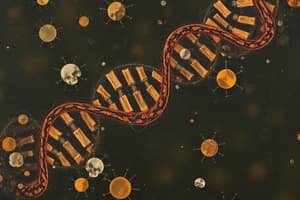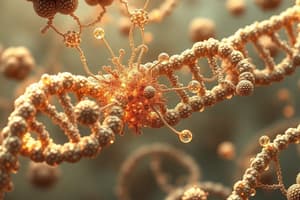Podcast
Questions and Answers
What are some types of errors that can occur in the DNA?
What are some types of errors that can occur in the DNA?
Damage to nucleotides, incorrect nucleotide pairing, disruptions in DNA strands
How do cells reduce mismatch errors in DNA?
How do cells reduce mismatch errors in DNA?
By using specialized enzymes and repair mechanisms
What environmental factor can cause chemical changes in nucleotides?
What environmental factor can cause chemical changes in nucleotides?
Factors like tobacco smoke
What type of DNA damage can UV radiation cause?
What type of DNA damage can UV radiation cause?
How are double-strand breaks in DNA repaired?
How are double-strand breaks in DNA repaired?
What are the consequences of faulty DNA repair mechanisms?
What are the consequences of faulty DNA repair mechanisms?
What can potentially lead to serious issues like cancer in cells?
What can potentially lead to serious issues like cancer in cells?
Which process is responsible for reversing chemical changes in nucleotides caused by environmental factors?
Which process is responsible for reversing chemical changes in nucleotides caused by environmental factors?
What type of radiation can cause distortions in the DNA double helix structure?
What type of radiation can cause distortions in the DNA double helix structure?
Which type of DNA repair mechanism involves processes like nucleotide excision repair?
Which type of DNA repair mechanism involves processes like nucleotide excision repair?
What can faulty DNA repair mechanisms be linked to, other than early aging and cancer?
What can faulty DNA repair mechanisms be linked to, other than early aging and cancer?
Which factor can cause chemical changes in nucleotides in cells?
Which factor can cause chemical changes in nucleotides in cells?
What is the most dangerous type of DNA damage that can lead to cell death?
What is the most dangerous type of DNA damage that can lead to cell death?
Which aspect of DNA mutations is highlighted as not always negative?
Which aspect of DNA mutations is highlighted as not always negative?
Flashcards are hidden until you start studying
Study Notes
- Our DNA in each cell is damaged tens of thousands of times per day, potentially leading to serious issues like cancer.
- Different types of errors can occur in the DNA, such as damage to nucleotides, incorrect nucleotide pairing leading to mutations, and disruptions in DNA strands during replication.
- Cells have various mechanisms, including specialized enzymes, to repair most of these DNA damage issues, reducing mismatch errors to about one in a billion.
- Chemical changes in nucleotides can be caused by environmental factors like tobacco smoke or natural cellular components like hydrogen peroxide, with enzymes dedicated to reversing the damage.
- DNA damage post-replication can be more complex to repair, such as UV radiation causing distortions in the DNA double helix structure, requiring processes like nucleotide excision repair.
- High-frequency radiation like gamma rays and X-rays can sever DNA strands, with double-strand breaks being the most dangerous as they can lead to cell death, repaired through mechanisms like homologous recombination and non-homologous end joining.
- DNA mutations are not always negative, as benign mutations can contribute to species evolution, but faulty DNA repair mechanisms are linked to early aging and various types of cancer, emphasizing the importance of DNA repair processes for cellular health.
Studying That Suits You
Use AI to generate personalized quizzes and flashcards to suit your learning preferences.




